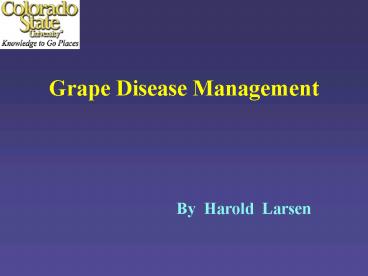Grape Disease Management - PowerPoint PPT Presentation
1 / 40
Title:
Grape Disease Management
Description:
Grapevine leafroll virus (GLRV) Grape Powdery Mildew. Caused by fungus, ... Seedless, Ruby Seedless, Cardinal, Chardonnay, Cabernet Sauvignon, & Chenin Blanc ... – PowerPoint PPT presentation
Number of Views:1699
Avg rating:3.0/5.0
Title: Grape Disease Management
1
Grape Disease Management
- By Harold Larsen
2
Primary Grape Diseases
- Powdery mildew
- Crown gall
- Bunch rot
- Grapevine leafroll virus (GLRV)
3
Grape Powdery Mildew
- Caused by fungus, Uncinula necator
- Reduces yield, vigor
- Reduces berry quality for wine
- Reduces vine and bud hardiness
4
Powdery Mildew - Symptoms
- Powdery mycelium on shoots, leaves, berries
- Russet stunting of berries
- Rusty spots on canes
- Flagged shoots (in spring, infected buds)
- Cleistothecia in fall on infected tissues
(leaves, shoots, canes)
5
Powdery Mildew - Leaves
Image at web site http//www.apsnet.org/online/f
eature/pmildew/galery.htm/img02.htm
6
Powdery Mildew - Colonies
Image at web site http//www.apsnet.org/online/fe
ature/pmildew/gallery.htm/img01.htm
7
Powdery Mildew Flagged Shoots
Image at website http//www.apsnet.org/online/fea
ture/pmildew/gallery.htm/img08.htm
8
Powdery Mildew - Conidia
Image at web site http//www.apsnet.org/online/fe
ature/pmildew/gallery.htm/img07.htm
9
Powdery Mildew on Fruit
Image at web site http//www.apsnet.org/online/fe
ature/pmildew/gallery.htm/img04.htm
10
Powdery Mildew - Cleistothecia
Image at web site http//www.apsnet.org/online/fe
ature/pmildew/gallery.htm/img06.htm
11
Powdery Mildew Fruit Russet
Image at web page http//www.apsnet.org/online/fe
ature/pmildew/gallery.htm/img05.htm
12
Powdery Mildew Cane Scarring
Image at web site http//www.apsnet.org/online/fe
ature/pmildew/gallery.htm/img03.htm
13
Powdery Mildew Disease Factors
- Cultivar susceptibility
- Availability of newly grown tissue
- Temperature
- Humidity / rainfall
- Inoculum source
14
Cultivar Susceptibility
- High Carignane, Thompson Seedless, Ruby
Seedless, Cardinal, Chardonnay, Cabernet
Sauvignon, Chenin Blanc - Moderate White Petite Sirah, Zinfandel,
Semillon, Riesling
15
Tissue Susceptibility
- New shoots / leaves
- New fruit
- (All tissues that lack well developed cuticle)
16
Temperature
- Mild weather favors powdery mildew (64o 84o F,
optimum 77o F) - Spores germinate _at_ 43o to 91o F
- Extended exposure to temperatures of 92o F or
more kills spores and mildew colonies - 12 hrs exposure to UV light temperature of 95o
F kills the fungal colonies completely
17
Humidity / Rainfall
- Spores can germinate at humidities as low as 20,
but 40 or more results in better germination - 12 15 hrs of continuous leaf wetness is needed
at temperatures of 50o 59o F - Dew formation also is adequate for spore
germination if it occurs early enough in the
evening (providing a long enough leaf wetness
period)
18
Inoculum Source
- Infected buds (result in flagged shoots in
spring) - Overwintering cleistothecia
- Conidia from infected vines (or other hosts)
nearby can include Virginia creeper, Boston
ivy, and monks hood vine.
19
Control Considerations
- Fungus can develop resistance to control
materials, so need to minimize risk of this - Many categories of control materials are
available - Materials also differ in how long they are
effective after application - Need to rotate chemistries or tank mix different
chemistries
20
Control Strategies
- Use predictive models to determine need for
sprays - Wait until see first infection, then apply
eradicative materials (Stylet oil, or jojoba oil)
- Start early, keep regular, rotate chemistries
- Use sulfur on 7 10 da intervals (until veraison)
21
Chemical / Control Categories
- Sulfurs (organic certification programs)
- Sterol inhibitors (DMIs)
- Strobilurins (new class of fungicides)
- Oils (some are eradicative)
- Potassium bicarbonate
- Biological control agents (mildew pathogens)
- Plant defense elicitors (new class)
- Mycophagous mites
22
Chemistry Groups - Sulfurs
- Wettable powders (8595 _at_ 5 lb/acre)
- Flowable formulations (6F 6 lbs / gal. _at_ 7
pts/acre prebloom, 1 gal/acre postbloom) - Micronized formulations (DF, e.g. Thiolux 80DF _at_
2-5 6 lbs/acre) - surfactant
23
Chemistry Groups DMIs
- Bayleton 50DF (_at_ 2-6 oz/acre)
- Nova 40W (_at_ 3-5 oz/acre)
- Procure 50W (_at_ 4-8 oz / acre)
- Rubigan 1E (_at_ 2-3 fl. oz./acre prebloom, 4-5
fl. oz./ acre postbloom, 5-6 fl. oz./ acre
summer) - surfactant
24
Chemistry Groups - Strobilurins
- Flint 50WDG (_at_ 2 oz./acre)
- Abound 2.08F (_at_ 11.0 15.4 fl. oz./acre)
- Sovran 50WDG (_at_ 3.2-4.8 oz./acre)
25
Chemistry Groups - Oils
- Stylet oil _at_ 2 soln.
- Jojoba oil (EcoErase _at_ 2 soln.
26
Chemistry Groups - Bicarbonates
- Potassium bicarbonate (Kaligreen 2.5 5 lb /
acre)
27
Chemistry Groups - Plant Defense Elicitors
(Experimental)
- Serenade (_at_ 6 lb / acre)
28
Biological Controls
- Ampellomyces quisquallis (AQ10 _at_ 0.5 1 oz/acre)
- Mycophagous mites (potential future option)
29
Example Control Program
- 2 shoot growth Sulfur _at_ 4 lb ai / acre
- 4 6 shoot growth DMI (Nova _at_ 5 oz/acre)
- 12 - 14 Strobilurin (Flint _at_ 2
oz/acre) - Flowering DMI (Nova _at_ 5 oz/acre)
- Flowering 14 da Strob. (Flint _at_ 2 oz/acre)
- Flowering 28 da sulfur _at_ 4 lb ai/acre
- Monitor planting Stylet oil as needed (_at_ 1.5
solution) - Annual Cost approx. 110 / acre / season
30
Crown Gall
Image at web page http//www.ipm.ucdavis.edu/PMG/
r302100911.html
31
Crown Gall
- Caused by bacterium, Agrobacter tumifasciens
(actually by phage within A. tumifasciens) - Bacterium enters by wounds, dumps the phage into
the cells, leaves - Phage then inserts self into cell DNA
- Result is tumor-like growth in host plant
32
Crown Gall
Images at web page http//www.cas.psu.edu/docs/CA
SDEPT/plant/fpath/grape/crgall.html and
http//www.ipm.ucdavis.edu/PMG/A/D-GR-ATUM-TR.002
.html
33
Crown Gall
- Control by Galltrol (Agrobacter radiobacter, a
competitor for sites on the host root) - Gallex control solution for treating wound
after removal of galled tissue.
34
Bunch Rot
35
Bunch Rot
- Caused by Botrytis cinerea various fungi
bacteria - Control via opening up canopy for air
circulation
36
Bunch Rot Early Stages
37
Grapevine Leaf Roll Virus
38
Grapevine Leafroll Virus
- Caused by a virus (GLRV)
- Transmitted by grape mealybug
- Symptoms are premature purpling and rolling of
foliage in Cabernet franc - No cure once infected
39
Grapevine Leafroll Virus
40
(No Transcript)

